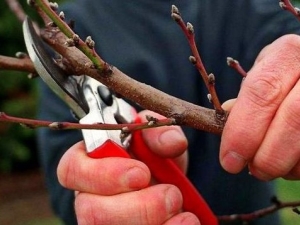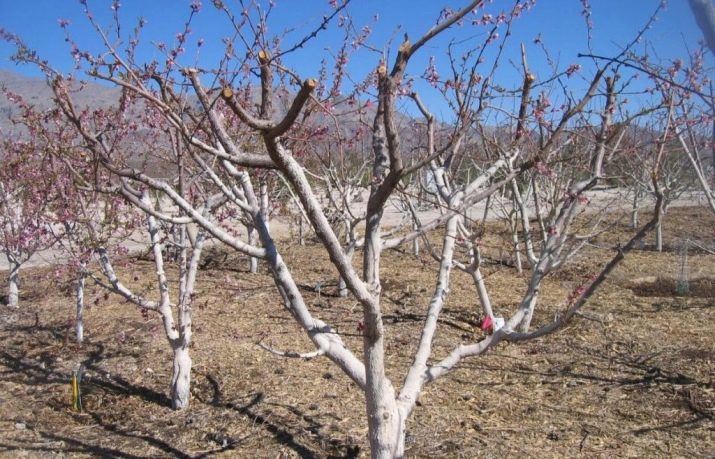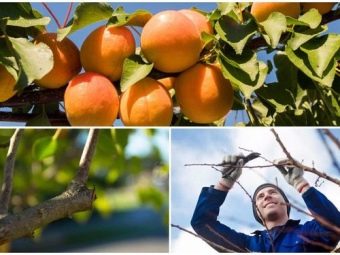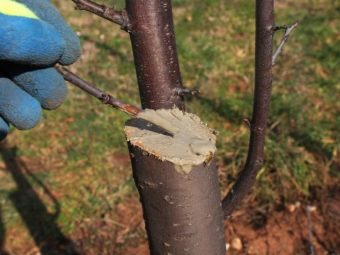Apricot pruning: types by purpose, requirements and technology

Apricots are wonderful fruit trees that bring not only benefits, but also are a wonderful decoration of the garden during their flowering period. They are grown not only in the south, but also in the central regions, and even in a not very mild climate. In order for the fruit trees to give a good harvest, they need not only proper care, but also timely pruning. By appointment, pruning of apricots is divided into types, during which certain requirements and technology must be observed.
Causes and types
Apricot needs annual pruning - rejuvenating and sanitary. Apricots are pruned in spring and autumn, and even in summer. In order for the tree to form, grow and bring the harvest, you need to prune it, following certain rules. If the apricot is not cut, its crown grows rapidly, many ovaries appear, then fruits. But all this leads to the fact that subsequently the fruit-bearing branches become smaller, the fruits themselves become smaller, their taste deteriorates. This is the important role of pruning in the life of a tree; therefore, it cannot be neglected in any way.
In the absence of pruning new shoots do not appear, existing branches can be overloaded with a large number of apricots and even break under their weight. That is why this process should be controlled by the gardener. Provided that the pruning is done constantly, the optimum crown is formed in the apricot, the fruits ripen large, juicy and sweet. By observing the right pruning conditions, the gardener increases the time during which the tree will delight with its appearance and beautiful fruits. Sanitary pruning is necessary for a tree not less than formative. Unnecessary branches growing inside the bush and thickening the crown, you need time to remove, as well as dried, and damaged branches that will no longer bear fruit.
Features and terms
In order for the tree to develop correctly, pruning is done at a certain time, observing the technology.
In the spring
The formation of the crown proceed to the next year after landing. Spring pruning is usually done in March or April, due to the fact that you need to do it before the moment when buds and leaves start to appear on the tree. But some gardeners, contrary to recommendations, carry it out in May. Spring pruning is done to ensure that the crown is lush, but at the same time there is good access to the sun's rays, which are necessary for the timely ripening of fruits. To do this, incorrectly growing branches are removed, others are simply pruned slightly.
The main thing is to timely remove dead branches, so that the tree does not use all its forces to restore them, which are needed for the formation of new shoots. If this is not done, the fruits will be crushed and their taste will deteriorate.
Summer
Summer pruning is called rejuvenating. The time of its holding is the first half of June. Her goal is to shorten new shoots, and in less than a month many new shoots will appear. From this large number you need to leave from three to five of the strongest shoots, the rest - cut. The wounds on the tree will quickly heal, and the crown will be replenished with new viable shoots.
Summer pruning is done to increase yield. But it should not be held every year; experienced gardeners advise it to be carried out once every three years. There is another nuance that needs to be considered.
If the summer is hot and arid, and the tree does not receive quite a large amount of water due to the inability of regular watering, it is better to refuse summer pruning. It will not change the state of the tree for the better, but, on the contrary, it will only aggravate the situation.
In the autumn
Autumn is the time for sanitary pruning. After the tree has left, it is necessary to prepare it for the winter, removing all the dried and damaged branches. Fruiting branches shorten in order to harvest was less, but better.From this procedure, apricots will be larger and will have a high taste.
The autumn pruning procedure is recommended in the middle of October, choosing a dry warm day for this. If for some reason this time was missed, and frosts have already begun, it is better to completely abandon the autumn pruning.
Scheme and rules
For novice gardeners, the main thing is to cut the apricot correctly, this is what determines the further formation of the tree and its fruiting. You should know that when the apricot begins to bear fruit, the growing season stops. To achieve a harmonious relationship between the two, you need to regularly pruning. It is considered that it is much more correct to remove 3-4 large branches than 8-10 small ones.
Thus, the crown will receive a sufficient amount of light for several years. When rejuvenating pruning by removing old branches gives life to young shoots. Branches that grow inward, cut to the ground, which will help to discharge the crown. The best method used for crown formation is sparse and longline.
Young tree
In the first year of life a tree may have a trunk without branches. In this case, it must be cut off, leaving no more than one meter from the ground. If the branching is, you need to find two branches located at the same height, and cut them, leaving equal parts cleaned. The remaining branches must be removed completely, not even leaving a few centimeters. All that is located below half a meter, you need to remove. In the summer, shoots that start to grow upwards and not sideways should be removed.
In the second year, the next part of the branches located on opposite sides of the trunk is laid. They should be at a distance from each other and other branches. It is necessary to observe an important condition: the lower branches must be longer than those located above. Skeletal branches from last year are also slightly shortened. Shoots are cut to a third or half, depending on the type of tree.
The third year is the last stage of laying the main branches. Everything happens according to the same principle: the main branches are cut in half, small ones - more. Verticals are completely removed. The fourth year for apricot is the beginning of the ripening of the first fruits. Pruning does not benefit, on the contrary, it can delay the process of fruit ripening. From this point on and the next three years, only damaged and dried branches should be removed, that is, sanitary pruning should be carried out. After three or even four years, more serious pruning can be done to update the tree.
Old
Mature apricot needs pruning for rejuvenation. It must be produced once every three or four years. Old apricot will benefit if the branches formed from the main branches are shortened by about 25 centimeters. With a shortage of fruits or their formation only in certain places, spring all shoots on skeletal branches should be cut, then the tree will give new fruit-bearing branches.
Care after the procedure
Good gardeners always look after trees, not occasionally. Apricot, like other fruit trees, needs full and regular care. Launched garden is a sad sight, while well-groomed and pleasant to the eye, and pleases with its harvest. After pruning, apricot needs special attention and good care.
- In order for a tree to quickly return to its former life, it is necessary to treat the wounds with a garden pitch, a rather thin layer. It is applied when the cut point dries a little. It usually takes about ten minutes. Garden var can be purchased at the store or cooked by mixing such components as vegetable oil, grease, rosin, beeswax and ashes.
- Copper sulphate can be used for disinfection. At the same time, it will scare away pests and serve as prevention of various diseases.
- Phosphorus, nitrogen and organic matter should be added to the soil.These fertilizers will help the tree recuperate faster.
It should be recalled that apricot refers to those trees that do not like drought. Therefore, it should be watered with a dry summer twice a month.
Common mistakes
The most common mistake is the opinion that the apricot can not be cut and give him complete freedom. If you do this, then the crown will form incorrectly, which then will affect the harvest. Although the first time fruits will be enough, this trend will not continue for a long time. Chaotic pruning is another common mistake. Pruning should be done according to the scheme, only then the tree will develop properly and will get everything necessary for successful growth.
Some people are mistaken in thinking that meeting the deadlines for pruning is optional. It is very important to do it in the proper months. In the spring - before the start of sap flow, in the summer - before the start of fruiting, in the fall - after the tree has sprouted.
Wrong pruning in late autumn, when cold rainy weather settled. This can greatly harm the tree, and in some cases and destroy it.
Gardeners tips
In the care of apricot is desirable to comply recommendations from experienced gardeners.
- The pruner, which will be pruned, must be sharp and clean. It is better to sanitize it before the procedure.
- Only small shoots (no more than thirty centimeters), growing from the lateral branches, regularly bear fruit, so be sure to shorten them. Otherwise, the harvest will be reduced from year to year.
- If apricots grow only in remote parts of the tree, in the spring all shoots growing from the sides should be removed from the skeletal branches. In the summer, the tree will be overgrown with new branches that will bear fruit.
- As for the autumn pruning, gardeners recommend it only if the trees have an early or medium ripening period.
- In order to properly and correctly cut, you need to prepare the necessary tools: a garden knife, a hacksaw, a secateur and a lopper. These tools need to be sharpened and treated with disinfectant fluid.
- Gardeners with extensive experience in the cultivation of apricots are recommended in the formation of the crown to give preference to the rarefied and longline method. Five or six main branches of the lower row should be located at a distance of about half a meter from each other.
Of course, not only pruning plays a role in the successful cultivation and timely ripening of apricot. It must initially be properly landed on a well-lit place, protected from the winds, to observe all the conditions for proper planting, and then ensure regular watering, protection from pests and fertilizer.
Only the use of all measures in the aggregate will allow you to grow a wonderful tree, giving tasty and healthy fruits.
On the simple rules of summer pruning apricot, see the following video.
































